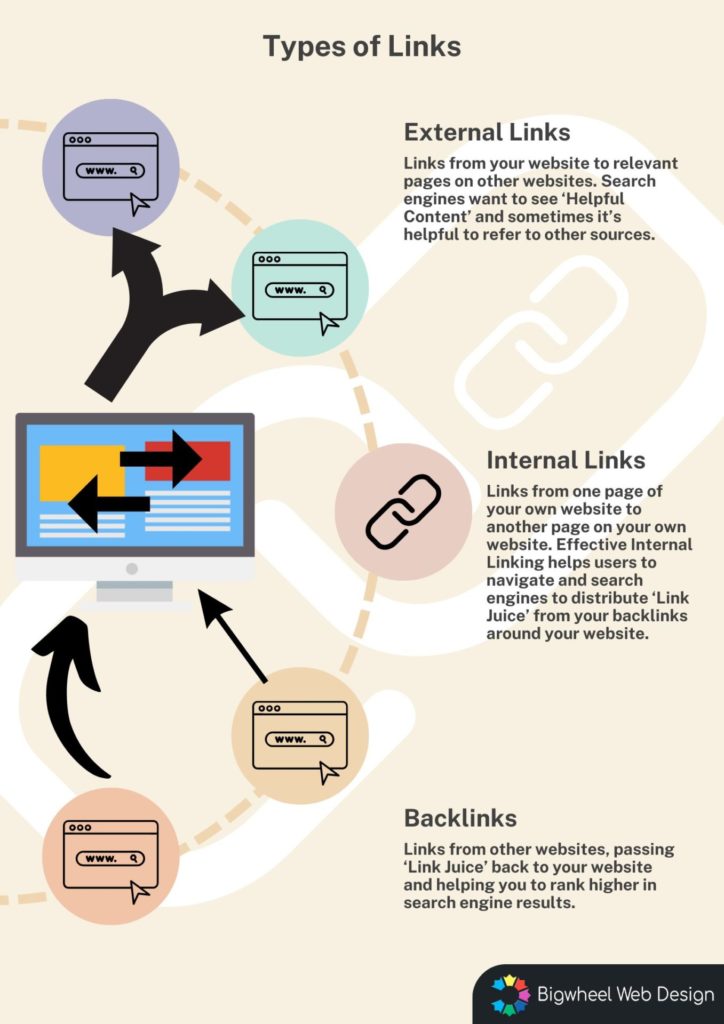Grasping the Fundamentals of Link Building
Link building is a core aspect of SEO, crucial for elevating a website's visibility in search engine rankings and enhancing organic traffic. This process hinges on the principles of quality, diversity, and fostering meaningful relationships. To devise an impactful link building strategy, understanding certain link building fundamentals and key concepts is indispensable. Beginners may find our Beginner's Guide to Link Building a helpful starting point. This article aims to dissect key elements of link building, such as link equity, relevance, authority, the nuances between follow and nofollow links, and strategies for optimising anchor text.

A summary of these pivotal concepts serves as a reference point for link building essentials.
Glossary of Key Concepts in Link Building Fundamentals
Link Equity (or 'Link Juice')
Link equity is the value a site passes to another through hyperlinks, commonly referred to as 'Link Juice'. This value's distribution is swayed by factors like the linking page's authority, its relevance to the topic, and the number of links it hosts. Proper application of link equity can markedly improve a page's search engine ranking.
Relevance & Authority
The relevance and authority of a linking page significantly influence the effectiveness of link equity. The domain's relevance to your niche and the context of the content surrounding the link are paramount. This ensures a seamless match between the linking and target pages. A domain's and its specific pages' authority, determined by the quality of inbound links, directly affects their search rankings. Grasping these concepts is vital for a successful link building initiative, enhancing your site's SEO link building strategies.
Follow vs. NoFollow Links
It's essential to distinguish between follow and nofollow links, as their impact on link equity varies. Follow links, or "dofollow" links, are integral to the web's structure, facilitating search engines' indexing processes. They pass on link equity, boosting the authority and ranking potential of the recipient page. On the contrary, nofollow links, marked with a rel="nofollow" attribute, are designed not to influence link equity. Their strategic use is crucial in distinguishing between endorsed content and user-generated or sponsored submissions. Despite not affecting SEO rankings directly, nofollow links can still drive traffic and enhance visibility, playing a role in a holistic SEO campaign.
Anchor Text Optimisation
The clickable text in a hyperlink, known as anchor text, is pivotal in SEO. It provides context to both users and search engines about the link's destination page. Optimal anchor text selection involves using relevant and descriptive terms without resorting to spammy repetition. A balanced approach, incorporating exact and partial match keywords, branded terms, and generic phrases, helps maintain a natural link profile and avert search engine penalties for manipulative practices.
Link Diversity
Link diversity reflects the range within a website's backlink profile, including links from various domains and domain types (e.g., .edu, .gov, .com, and .co.uk), and featuring assorted anchor texts. Such diversity signals to search engines the broad appeal and trustworthiness of your content, positively impacting rankings. Attaining link diversity involves securing links from a mix of authoritative sources, blending follow and nofollow links, and adhering to authentic link building practices, thereby bolstering your SEO performance.
PageRank
Google's PageRank algorithm, though less publicly emphasised now, remains a cornerstone in understanding the impact of links on a page's authority and ranking. Named after co-founder Larry Page, it calculates the importance of a website based on the quality and quantity of links pointing to it. Links from high-authority sites are deemed more influential, reinforcing the significance of cultivating a robust link profile.
Toxic Links
Mitigating toxic links is imperative for sustaining a healthy backlink profile and safeguarding your SEO efforts. These links, originating from dubious or low-quality sources, can degrade your website's SEO performance. Black-hat SEO tactics, like link farms or paid link schemes, often produce such detrimental links. Utilising tools such as Google's Search Console and SEMrush's backlink audit feature, webmasters can identify and disavow harmful links to maintain a pristine backlink landscape.
The Importance of Link Building Fundamentals in SEO
Link building occupies a central role in SEO, with a diversified backlink profile signifying your domain's credibility. A rich array of links, encompassing various domains and anchor texts, underscores your authority, propelling organic search traffic. Effective anchor text optimisation, acknowledging the original PageRank algorithm's insights, and employing strategic link acquisition tactics are crucial for maximising link building benefits.
Exploring Different Types of Links
Comprehending the spectrum of links is essential for mastering link building fundamentals and crafting a successful SEO strategy. This includes:
- Internal Links: Connecting one page of your website to another.
- External Links: Directing from your site to other websites.
- Backlinks: Incoming links from external sites to yours.
Link building predominantly involves acquiring backlinks to garner link equity. Moreover, internal linking enhances site navigation and search engine indexing, distributing link equity internally and contributing to a superior user experience.
Subcategories of Backlinks
Backlinks, while generally beneficial for SEO, come in various forms, each serving different purposes and acquired through distinct strategies. Understanding these subcategories can help refine your link building tactics and achieve more targeted SEO outcomes:
- Naturally Acquired Links: These are the gold standard of backlinks, earned without direct action. They occur when other website owners link to your content because it is informative, engaging, or valuable. Naturally acquired links are a strong endorsement of your site's quality and relevance.
- Business Directory Citations: Listings in reputable business directories can serve as valuable backlinks. These citations not only help improve local SEO but also direct potential customers to your site. Our Directory Citation Building service ensures your business is featured in essential, industry-relevant directories, enhancing your online presence and SEO.
- Guest Post and Editorial Backlinks: Contributing content to other websites or having your work featured in articles and editorials can generate high-quality backlinks. Our Guest Post Link Outreach service facilitates this by identifying and securing opportunities for you to share your expertise on other platforms, thereby earning authoritative backlinks.
- Link Insertions (a.k.a. Niche Edits): Adding a link to an existing article or page can be an effective way to gain backlinks. Our Link Insertions service focuses on placing your links in relevant, high-quality content across the web, ensuring that each backlink is contextually integrated and adds value to the existing discussion.
Incorporating a mix of these backlink types into your link building strategy can diversify your profile and enhance your website's authority and search engine rankings. Remember, the quality of backlinks often outweighs quantity, making it important to focus on building meaningful, relevant connections within your industry.
Strategies for Effective Link Acquisition
The relevance of incoming links is a critical factor in SEO, influencing how search engines appraise your website's value. Familiarising yourself with domain authority (DA) and page authority (PA) concepts is essential, as they predict a site's ranking potential. Crafting precise, relevant anchor texts and maintaining a vigilant stance against toxic links are key to optimising your SEO performance and securing a commendable search engine standing.
Identifying Quality Links: What to Look For
The architecture of your website benefits immensely from proficient internal linking, which bolsters user navigation and site structure. Pursuing high-quality backlinks, indicative of your site's worth to search engines, necessitates a strategic and informed approach to link acquisition. The potency of your backlink profile can significantly affect your visibility in search results, emphasising the need for diligent enhancement of site authority through strategic link building.
Frequently Asked Questions on Link Building Fundamentals
Acquiring hyperlinks from other websites to bolster your own site's SEO.
By signalling to search engines the value and trustworthiness of your content, thereby improving your search rankings.
Internal links, external links, and backlinks play distinct roles in an SEO strategy.
Generating shareable content, guest blogging, and social media promotion are among the tactics for attracting quality links.
Quality links originate from authoritative, relevant sites, contributing positively to your SEO.
They can diminish your site's SEO performance, leading to lower search rankings.
Only backlinks from reputable sources boost SEO; others from dubious sites can be detrimental.




[…] In the digital marketing sphere, mastering the nuances of link types is crucial for SEO success. Here, we explore the primary categories: internal links, external links, and backlinks, each playing a unique role in SEO. If you’re feeling a bit lost at this point, it might help to read our previous article on Link Building Fundamentals: Key Concepts for 2024. […]